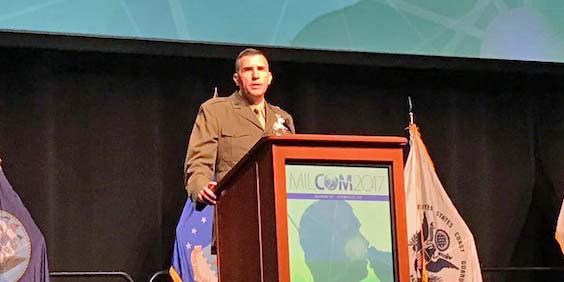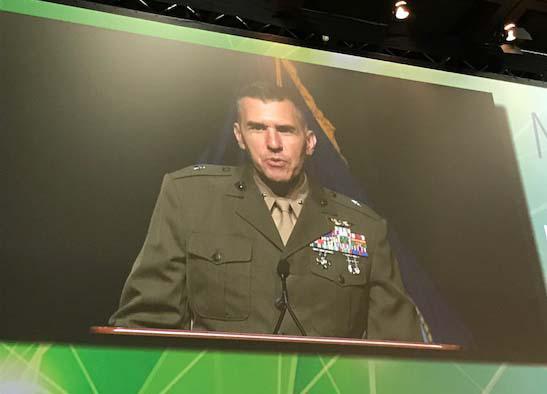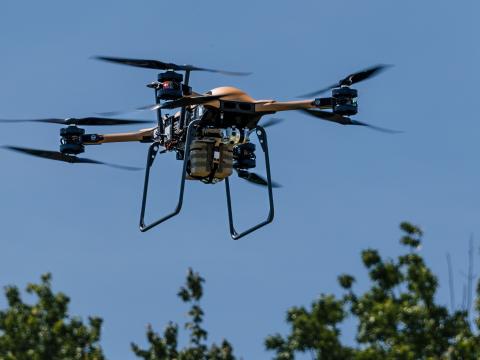Budget Constraints, Technology Needs Challenge Marine Corps
The challenges involved with being the CIO for the Marine Corps include balancing the service’s evolution with its technology needs and finding the right technologies for warfighters on a tight budget with changing operational needs. “There is a lot of change going on in the Marine Corps and that change is fantastic,” said Brig. Gen. Dennis Crall, USMC, director C4/Chief Information Officer (CIO).
Moreover, how the Marine Corps looks at success is vastly different. Metrics look at money savings but more importantly, examine warfighting capabilities and abilities against adversaries. “Sometimes it’s not cost effective; sometimes we spend money for lethality,” Gen. Crall said in Baltimore at MILCOM, co-sponsored by AFCEA and IEEE. “It’s not always a cost avoidance or an offset. Sometimes it's additive. And when as a soldier you’re closing in on those last few 100, 50, 10 yards, you are not thinking about your balance sheet. You are thinking about that lethality coming to bear. We need to make sure we have our warfighting prowess, first and foremost, in everything we do.”
As the CIO, the general does take notice of what his counterparts are doing in private industry. He is envious of a few of the advantages in the corporate world, including with how quickly CIOs in the commercial sector can affect change in an organization. “They can do the analysis, make a decision and move on it,” he said. Never is there a discussion on the color of money that’s involved. Gen. Crall said he may have funding, “but it’s not necessarily in the right flavor. And changing those flavors is extremely hard.”
Another challenge is the “seemingly habitual” continuing resolution budget status from Congress. Lawmakers’ inability to approve a budget for DOD, instead relying on continuing resolutions, “really does make it hard to do business with the military.”
As far as taking a risk on new technologies, referred to as “lead turning” in the industry, Gen. Crall remarked that “there is not a lot of lead turning. [Instead] we do a lot of tail gunnery in the military.” It seems like the service's motto is “after trying everything, we’ll eventually do what is right. We are slow on the take and we have no capital funds for IT, which hurts us," he said.
There are some unique things in how the USMC runs the CIO’s shop,the general said. Expenditures for information technology expenditures is run out of the C4 office and Gen. Crall is the authorizing official for the Marine Corps. “Without those two throttles,” he said, “everything is just a polite conversation.” He added that the Secretary of Defense’s office has been very flexible in working with the CIO’s office to push some procurement authority down, so that requesting units and the right officials for expenses can have authority for IT purchases of $150,000 and below. He said they aim to have this new authority in place by the end of the calendar year.
The CIO is building “packages” to incentivize clients, marking a fundamental change. IT will increase standardization, make networks safer, improve configuration and speed up procurement of needed gear without sacrificing security.
One of the priorities the Marine Corps has been working on for the last two years is to “comply to connect,” which includes a software component (for the ability to see their networks), a hardware component (network access controls) and installation processing nodes to modernize Marine Corps data centers and reduce the number of core data centers.
Gen. Crall admitted the service is“too slow” in response to threats to networks. He is looking to artificial intelligence as a solution. “We need to see anomalies, and look at our networks smarter and quicker,” he said.
Another important piece is mobility. “We need to take our network and data with us.” Already the service relies on data, and in the midst of a data explosion, the service needs to find ways to store and effectively use that data. “The age old question of where is your data – behind you, with you or in front of you, the answer really is yes,” he said. “Data needs to be everywhere, because we are going to operating in a contested environment and we are not prepared right now to fight in that environment.”
The Marine Corps also is looking for modernized equipment with lower size, weight and power needs. That mobility, when combined with important wireless capabilities will allow the service to operate successfully on the tactical edge, Gen. Crall said.





Comments